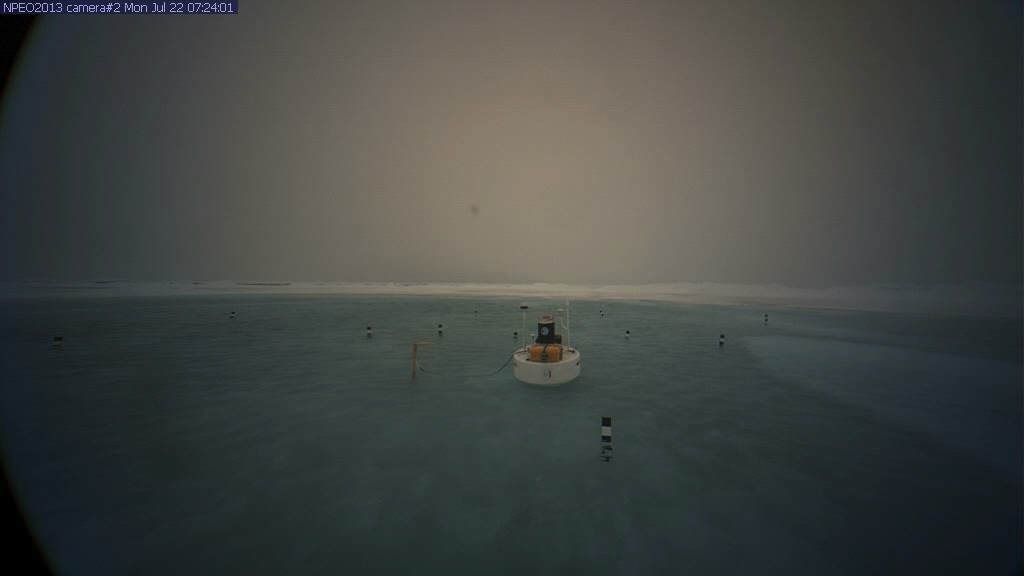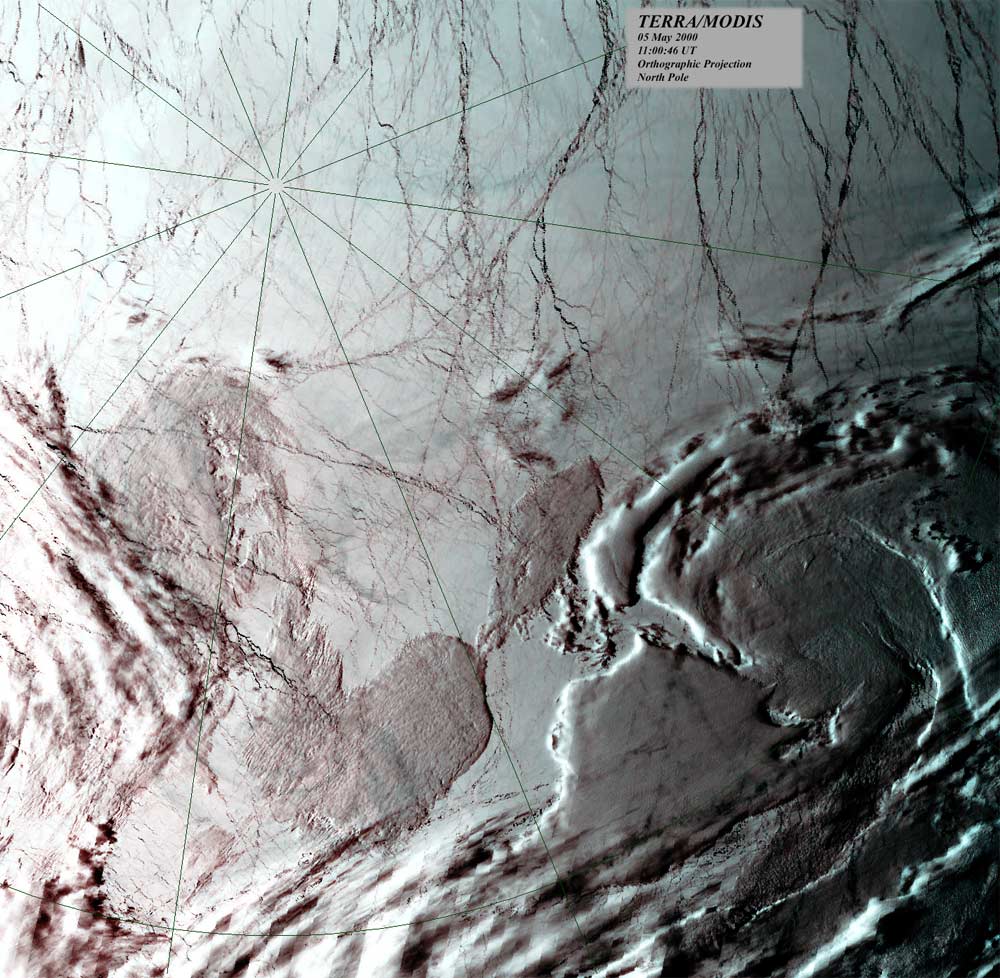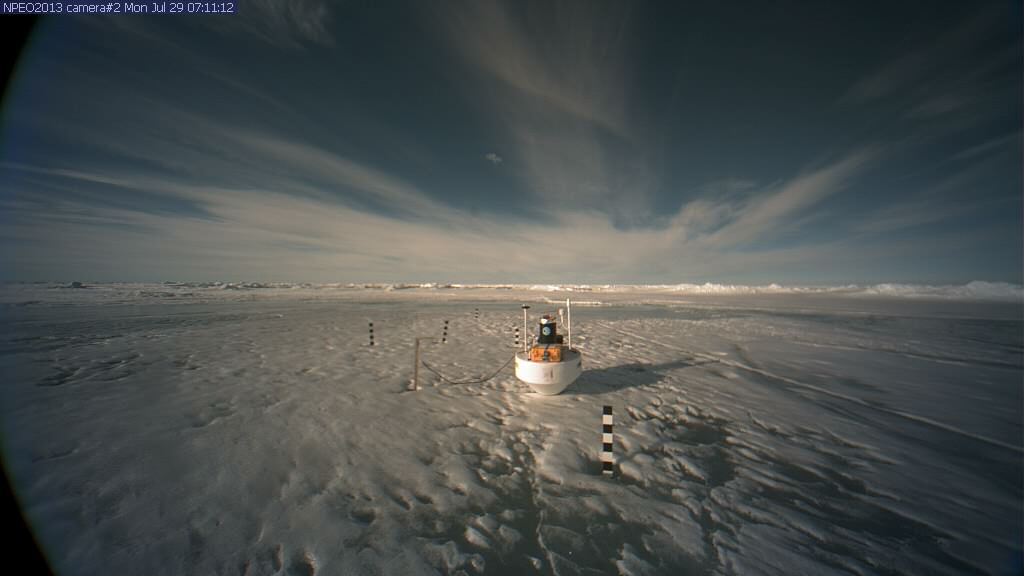The North Pole: Location, Weather, Exploration … and Santa

The "North Pole" has multiple meanings; it can indicate the geographically northernmost point on Earth or to the spot where compasses point. And, most enchantingly, it can refer to Santa's headquarters. The North Pole has inspired human imagination, scientific exploration and political conflict for decades.
Where is the North Pole?
The Geographic North Pole is the northernmost point on the planet, where Earth's axis intersects with its surface. Its latitude is 90 degrees north, and all longitudinal lines meet there. From there, every direction one turns is south. Because all longitudinal lines begin from it, the North Pole has no time zone.
The pole is surrounded by the Arctic Ocean, where the water is 13,400 feet (4,084 meters) deep and usually covered with drifting ice 6-to-10 feet (1.8 to 3 m) thick. About 434 light-years above the pole lies Polaris, the "North Star." During the course of the night, Polaris does not rise or set, but remains in very nearly the same spot above the northern axis year-round while the other stars circle around it. The star has been an important marker for navigation for centuries.
Over time, the location of the North Pole changes slightly. Earth's axis has a slight wobble, and since the pole intersects with the axis, it wobbles along with it. Scientists have calculated that the pole wobbles about 30 feet over seven years. The precise point of the pole at any given moment is known as the instantaneous pole.
In recent years, scientists have noticed that the axis is drifting rapidly eastward because of climate change. Since 2000, the pole has been moving steadily eastward by about 75 degrees, heading toward the Prime Meridian that runs through Greenwich, England, according to Surendra Adhikari, an Earth scientist at NASA's Jet Propulsion Laboratory in California. Adhikari said in a 2016 National Geographic article that the axis has shifted about 10 centimeters (4 inches) per year. Scientists suspect that rapidly melting ice sheets have caused a redistribution of mass. Melting ice moves mass around by adding water to the oceans and lightening the load on ice-covered crust, according to a 2005 Live Science article.
Magnetic North Pole
The Magnetic North Pole is not the same as "true north"; it is several hundreds of miles south of the Geographic North Pole. Earth's iron core and movement within its outer part generates a magnetic field, and the magnetic North and South poles are where the field is vertical. Compasses point to the magnetic North Pole.
However, what we call the Magnetic North Pole is actually a south magnetic pole. Magnetic field sources are dipolar, having a north and south magnetic pole. Opposite poles (N and S) attract, and like poles (N and N, or S and S) repel, according to Joseph Becker of San Jose State University. This creates a toroidal, or doughnut-shaped field, as the direction of the field propagates outward from the north pole and enters through the south pole. In other words, the north pole of one magnet is attracted to the south pole of another magnet. Because Earth's Magnetic North Pole attracts the "north" ends of other magnets, it is technically the "south pole" of the planet's magnetic field.
The magnetic poles and the geographic poles don't line up, and the difference between them is called declination. Since its discovery in 1831, the Magnetic North Pole has been around Canada's Ellesmere Island, about 500 miles (800 kilometers) from the Geographic North Pole. But the magnetic field drifts, causing the angle of declination to change over time.
Currently, the Magnetic North Pole moves about 25 miles (40 km) each year in a northwest direction — at a faster rate than it has moved since tracking began in the 1830s. The change could cause problems for migrating birds and human navigation. Eventually, the magnetic North and South poles will move to the point that they "flip" and compasses would point south. This change will happen slowly and not in our lifetimes. The last "flip" occurred 730,000 years ago.
North Pole weather
Because of Earth's tilted axis, the North Pole experiences only one sunrise and one sunset every year, at the March and September equinoxes, respectively. During the summer, there is sunlight all day; during the winter, it is always dark.
During the winter, the Geographic North Pole's annual mean temperature is minus 40 Fahrenheit (minus 40 Celsius). In the summer, it is 32 F (0 C). Though it is by no means warm, it is considerably warmer than in the land-based South Pole in Antarctica, because the North Pole is over water.
Research stations have reported cyclones at the North Pole and, in recent years, ice melt and cracks, which is part of Arctic climate change.

On thin ice
Scientists predict that ships will be able to sail directly over the North Pole by the year 2050. In fact, the Arctic ice sheet will be thin enough for ice breakers to carve a straight path between the Pacific and Atlantic oceans, according to a study by researchers at the University of California, Los Angeles (UCLA). Another study found that by the end of the 21st century, the Northern Sea Route could be navigable for more than half the year.
In particular, the Arctic has experienced major ice decline within the last decade. So what is happening? Typically, the ice follows a seasonal cycle. For example, in the spring and summer months, the warmer temperatures cause the ice floating on top of the Arctic Ocean to shrink. Then as the temperatures drop in the fall and winter months, the ice cover grows again until it reaches its yearly maximum extent, typically in March.
In 2017, however, a combination of warmer-than-average temperatures, winds unfavorable to ice expansion, and a series of storms halted sea ice growth in the Arctic. In fact,on March 7, 2017, Arctic sea ice reached a new record low for wintertime maximum extent, according to NASA. Overall, the ice reached just 5.57 million square miles (14.42 million square kilometers), which is 37,000 sq mi (97,00 sq km) smaller than the previous record low set in 2015, and 471,000 sq mi (1.22 million sq km) smaller than the average maximum extent for 1981-2010.
In fact, on Feb. 13, 2017, the combined level of Arctic and Antarctic sea ice was at its lowest point since satellites began measuring polar ice in 1979. According to NASA, the total polar sea ice on this date covered only 6.26 million square miles (16.21 million square km). This number is 790,000 square miles (2 million square km) smaller than the average global minimum extent for 1981-2010. This is equivalent to losing a chunk of sea ice bigger than Mexico.
North Pole ecosystem
The most frequent above-ice inhabitants of the Arctic are migratory birds, such as the small snow bunting, fulmar, kittiwake and the Arctic tern, which has the longest migration of any bird, traveling 43,000 miles (69,200 km) round trip from the North to South Pole every year. Caribou and Arctic foxes do not venture to the North Pole; polar bears make rare appearances. [Photos: Life at the North Pole]
Under the ice, one finds small crustaceans, shrimp, sea anemones and several species of fish, the most common being the Arctic cod. Marine mammals such as narwhals and other whales rarely venture so far north, though ring seals have been spotted occasionally.

Discovery and exploration
The Arctic had been explored for centuries as expeditions sought a Northwest Passage — a sea route from the Atlantic to the Pacific oceans. The 19th century brought the first major attempts to reach the North Pole. British Admiral William Edward Parry led an expedition in 1827, followed by Norwegian explorers on a land-based trek, a Swedish explorer who tried to reach it by hydrogen balloon, and many others. None of these expeditions was successful.
Peary vs. Cook
In the early 20th century, two explorers each claimed to have reached the North Pole first. An American physician, Frederick Albert Cook, announced in September 1909 that he and two Inuit companions had reached the pole on April 21, 1908. A week later, American explorer Robert E. Peary claimed to have reached the North Pole on April 6, 1909, accompanied by Matthew Henson, the first African-American Arctic explorer, and four Inuit men.
Peary had powerful sponsors, including The New York Times and the National Geographic Society, which had funded the expedition. Peary, who had made two previous attempts to reach the pole, called Cook a fraud. To make their case, the men published accounts of their journeys in a booklet titled "At the Pole With Cook and Peary," which became a bestseller and helped sway public opinion. Over the years, the controversy simmered.
However, new research in 1988 revealed that Peary's claim might have been suspect. Questionable elements of his claim included: the lack of navigational experience on his team; the fact that after the one person who had navigational experience left the team, they reported traveling at twice the speed; that one member's route description differed from Peary's; and that Peary never made his records available for review.
In 2005, British explorer Tom Avery mimicked Peary's route using dog sleds, and reached the pole, suggesting that Peary's records might have been accurate. The Peary vs. Cook debate remains controversial to this day.
Admiral Byrd
Since the days of Peary and Cook, many expeditions to the North Pole have taken place by plane, by foot and by dog sled. In 1926, American explorer and retired Navy admiral Richard Byrd claimed that he and his pilot, Floyd Bennett, had flown over the North Pole. The National Geographic Society, one of his sponsors, confirmed the accomplishment. Byrd was hailed as a hero, given the Medal of Honor and went on to fly over the South Pole, as well as achieving many other polar expedition milestones.
However, Byrd's accomplishment was questioned almost immediately. Many did not think his airplane could have covered the distance in just 15 hours and 44 minutes, as he had recorded. New research, published in the January 2013 issue of the journal Polar Record, suggests that Byrd fell short of his North Pole goal by as much as 80 miles (130 km).
Roald Amundsen
The first verifiable, convincing expedition to the pole is credited to Roald Amundsen, an intrepid Norwegian explorer. In 1903, Amundsen led the first expedition to cross the Northwest Passage. In 1911, Amundsen was the first person to reach the South Pole. And in May 1926 (just a few days after Byrd's flight), Amundsen flew — or rather, floated — over the pole in a dirigible, the Norge, with 15 other men.
Other polar milestones
April 23, 1948: Three Soviet crews land the first planes at the pole.
Aug. 3, 1958: The submarine USS Nautilus is the first naval vessel to reach the pole.
April 19, 1968: Ralph Plaisted of Minnesota reaches the pole by snowmobile.
1968-1969: Wally Herbert reaches the pole by dogsled (the first person to reach it on foot).
Aug. 17, 1977: The Soviet nuclear-powered icebreaker Arktika is the first surface ship to reach the pole.
May 1, 1986: The first expedition to reach the pole on foot without resupply includes Ann Bancroft, the first woman to travel to the pole.
2007: British lawyer and endurance swimmer Lewis Gordon Pugh swims 18 minutes for one kilometer in the Arctic Ocean at the North Pole. His feat, accomplished wearing only a swim brief, was done to draw public attention to the melting ice caps.
Ownership disputes
Currently, no country owns the North Pole. It sits in international waters. The closest land is Canadian territory Nunavut, followed by Greenland (part of the Kingdom of Denmark).
However, Russia, Denmark and Canada have staked claims to the mountainous Lomonosov Ridge that runs under the pole. The Arctic is rich in natural resources, including oil and gas, and valuable as a shipping route, making it of high importance to countries with Arctic coasts. In 2007, Russia sent the first submersible to reach the seabed under the North Pole, and dropped a titanium flag there — much to the displeasure of the other Arctic countries.
In December 2013, Canada announced plans to submit a proposal to the United Nations claiming the North Pole as part of Canadian territory. Their claim will not go unchallenged — both Russia and Denmark are expected to file claims, as well.
But the North Pole really belongs to … Santa Claus
Believers know that no matter what the science or explorers say, the North Pole is home to flying reindeer and toy-making elves hard at work. Canada's postal service claims itself among these believers, giving the postal code HOH OHO to letters addressed to Santa at the North Pole. Alaska has a Christmas-themed town known as North Pole, though it is actually nowhere near the North Pole. Other Arctic countries claim Santa's residence, mostly notably Finland. The idea that the jolly old elf lived in Lapland gained popularity during the 1920s.
No one knows precisely where the legend of Santa Claus living at the North Pole came from, but many identify American illustrator Thomas Nast as the man who officially gave Santa his residence. In 1866, Nast, whose images of Santa helped to popularize the American idea of the icon, published a drawing called "Santa Claus and His Works" in Harper's Weekly. The image features the words "Santa Clausville, N.P." At the time, the Arctic was a place of public fascination and expeditions received a great deal of attention, so viewers would have understood Nast's abbreviation.
Additional reporting by Traci Pedersen, Live Science contributor.
Additional resources
Sign up for the Live Science daily newsletter now
Get the world’s most fascinating discoveries delivered straight to your inbox.
Jessie Szalay is a contributing writer to FSR Magazine. Prior to writing for Live Science, she was an editor at Living Social. She holds an MFA in nonfiction writing from George Mason University and a bachelor's degree in sociology from Kenyon College.










